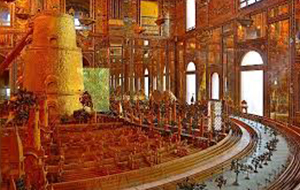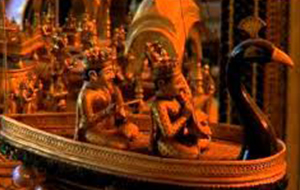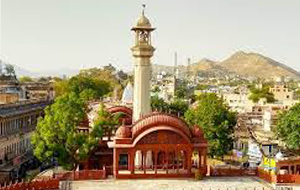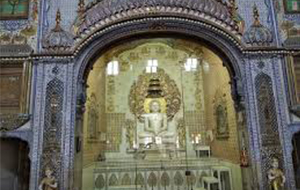The Ajmer Jain temple, also known as Soniji Ki Nasiyan, is an architecturally rich Jain temple. It was built in the late nineteenth century. The main chamber, known as the Swarna Nagari “City of Gold”, has several gold-plated wooden figures, depicting several figures in the Jain religion. This golden chamber of the temple uses 1000 kg of gold to carve out a depiction of Ayodhya.
Greatly revered by the Digambar sect of the Jains, the Nasiyan temple is dedicated to Rishabhdev, first of the 24 tirthankara by Rai Bahadur Seth Moolchand and Nemichand Soni. It is situated on Prithvi Raj Marg in Ajmer, the heart of Rajasthan state in India. The foundation of this magnificent Jain temple was laid on 10 October 1864 and the image of Rishabhdev (Adinath), was installed in the Sanctum Sanctorum on 26 May 1865. This work was carried out under the able guidance of the great scholar Pandit Sadasukhdasji of Jaipur.
The name of the temple is Siddhkoot Chaityalaya. It is also known as ‘Red Temple’ as it is built of red sandstone or ‘Nasiyan of Seth Moolchand Soni’ signifying the founder’s name. After the Svarna Nagri was added to the temple in 1895 A.D. it popularly began to be called as ‘Sone ka Mandir’ or ‘Soni Mandir’ emphasizing the golden structure as well as the family name. The halls of this temple are adorned with fascinating series of large, gilt wooden figures and delicate paintings that display scenes from Jain scriptures.
Ajmer’s main attraction is – for the Jainas – the prominently situated Nasiayan Digambara Temple, or rather the two-storied Svarana Nagara Hall behind the temple, better known as the Museum. Both the temple and the museum were built and are still owned by the Soni family of Ajmer. The temple, dedicated to Rishabha or Adinatha in 1865, was constructed of red sandstone in a matter of a few years, but it took twenty-five years, from 1870 to 1895, to fashion – by artisans at Jaipur – the thousands of individual parts required to assemble a three-dimensional replica of the story of Rishabha in accordance with an old manuscript by Acharya Jinasena.
The thought to have such a three-dimensional model for educational purposes occurred to Seth Moolchand Soni, who was born in 1830, only after the completion of the temple. His death in 1891 prevented him from seeing his ambitious work in its finished state.






